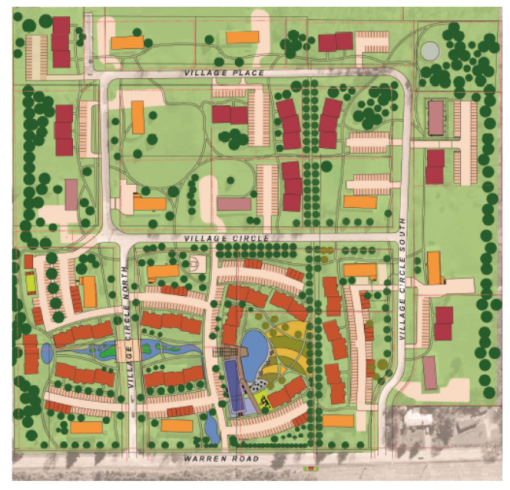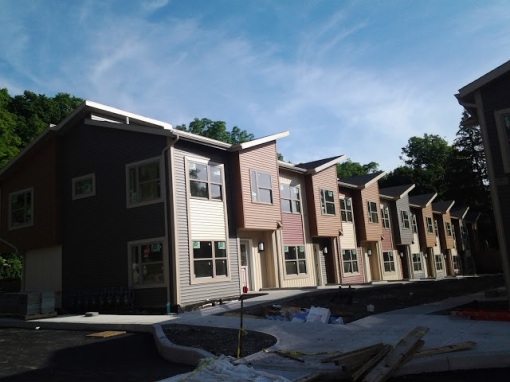So there’s been some news regarding the Village Solars buildout. The community center is in flux. The original proposal was for a mixed-use building with ground-level commercial and community amenities, and 20 one-bedroom apartments on the upper levels. Now, it’s an unknown. Per the Lansing Star:
“(T)hey will relocate the community center site to a location more central what will become an enlarged, single development. The lower floor would have amenities like a restaurant, a work-out center, and other features, with apartments on the upper floors. If not, they would build the smaller community center as already accepted by the Town.”
That means that the community center is being moved to another location on the site, and potentially take a different physical form, though programmatically it remains the same (commercial/community use on the ground level, residential above).
When the article says a more central location, it refers to the 96.44 acres of land east of the complex. The Village Solars are owned by Steve Lucente, and the undeveloped land to the east by his father Rocco, who had purchased it in 1960 and was recently planning his own apartment complex (schematic in the early Village Solars site plan below). My understanding is that the two Lucentes didn’t get along at all – I was warned to never bring up Steve when interviewing Rocco. After Rocco passed away about 18 months ago, Steve saw an opportunity to purchase the vacant land to the east from Rocco’s estate, and build a bigger complex in future phases (as yet unapproved). The purchase offer, at least check, is still being reviewed by Rocco’s Executors.
However, this created a problem. Local Law #6 of 2017, the Planned Development Area (PDA, like Ithaca’s PUD it’s D-I-Y zoning) with the town, stipulated that the community center had to be built and open by the end of 2020, and only one more apartment building could be built before it was done. So Steve Lucente and his project team had to make the case to the town of Lansing Planning Board and Town Board give them time to purchase the land and design the new community center, and let them do three more apartment buildings in the meanwhile to keep on pace with their construction plans. If the offer feel through, he’d build the community center starting next summer and finishing in 2021, a year later than initially planned. Generally, of all the communities to have to make such a request, Lansing would be one of the most accommodating.
This caused some debate, with some of the planning board feeling like their credibility was taking a hint with this latest delay (the community center was delayed at least once, hence why it was explicitly stated in the 2017 PDA revision), and at least one member of the town board feeling as if they were purposely misled since banks would have received the notice of intent to modify the plans several months ago, but Steve Lucente countered that it was not a firm plan and only became firm later in the year when the offer looked like it had a good chance of being accepted. On a 3-1 vote, the town is permitting three more apartment buildings and only two more, and expects a community center to start next year in either the old or the new location.
At this point, the last of the originally permitted buildings, 24-unit 36 Village Circle North (3 three-bedrooms, 6 two-bedrooms, 3 one-bedrooms and 12 studios) has had its foundation footers poured and is awaiting the concrete slab pour. The tarp and mesh are in place for stability and added strength respectively, and you can see the below-ground utilities poking out, capped for the time being. A surveyor was on site during this visit to make sure everything was level and in good order before the wood frame starts to rise. The three newly permitted buildings are all reconstruction of existing 8-10 unit buildings, into two 18-unit buildings (2 Village Place, 22 Village Place) and one 24-unit building (117 Village Circle North).
Apparently, occupancy rates have been strong. Building “L” (113 Village Circle North) opened in June, and 22 of its 24 units were spoken for, with the other two rented shortly after.
As for the future, it’s not clear. Something will be proposed that may very well require more PDA amendments, but we’ll see. The elder Lucente’s complementary apartment complex was supposed to be around 300 units in size (built over several years), and it wouldn’t be a surprise if the Village Solars plan expands by a similar amount.
























